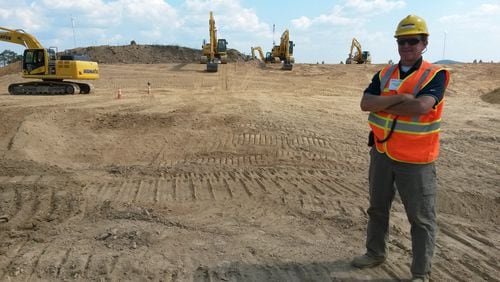Related video: What it's like to drive a 'smart' bulldozer when you don't know what your doing
Find Matt on Facebook (facebook.com/mattkempnercolumnist) and Twitter (@MattKempner) or email him at mkempner@ajc.com.
Other Kempner's Unofficial Business columns: http://www.myajc.com/flist/business/unofficial-business-column-matt-kempner/f9y/
What I did with a bulldozer in a Cartersville dirt patch was ugly.
I was supposed to make the ground pancake flat. What I actually left in my wake was a bunch of humps and swirls that looked like a ragged series of six-pack abs. Which is a costly mistake in the heavy equipment business.
That’s the risk of letting a writer grapple with two joysticks while driving 20-ton bulldozer worth hundreds of thousands of dollars. It was way more difficult than when I played with Tonka trucks as a kid, but just as much fun.
“You would not be the first person to roll a machine,” said a PR guy for Komatsu, an international equipment maker who invited customers (and me) to try out giant machines at one of its research and development centers.
Then I clicked to a setting to make the bulldozer semi autonomous. Suddenly, there were two of us in the cab: Me and the machine, and it started doing all the tough thinking. It constantly adjusted the blade to cut only as deep as needed, factoring in the ground’s changing material the way a human operator digs “by touch.” I could focus on just driving the lumbering vehicle.
Just as semi self-driving cars are hitting the nation’s highways, autonomous features are becoming more common in powerful construction equipment, too.
I wanted to see how quickly the technology could turn a newbie like me into an acceptable operator.
This has big ramifications for construction machinery jobs — and possibly for workers in other sectors as well.
If you could speed up the learning curve for workers or skip steps altogether with smart machines, skilled jobs could open up to more newcomers. That part sounds great. I just wonder if veteran operators will be undercut by the new competition.
So far, the construction sector hasn’t made the kind of productivity leaps that reshaped manufacturing and farming in the last 20 years.
On plenty of construction sites, survey crews still go out with hammers and sticks to mark how deep to dig. Equipment operators eyeball the stakes as they rumble by.
Compare that with technology that’s been rolling out for years: Dozers guided by GPS can be preset with site models that dictate where and how much the machines dig.
‘Whose butt is in the seat’
“If the model is right, it doesn’t matter whose butt is in the seat,” John Reigard told me.
His wife owns Grade A Construction near Nashville, Tenn., and the two were at Komatsu’s Cartersville site to spend hundreds of thousands of dollars for a new “intelligent” machine. Autonomous tech is also available from other equipment makers, including Caterpillar and JCB, both of which have major operations in Georgia.
It’s a pricey upgrade, though, and by some estimates only a quarter of the construction fleet in Georgia is outfitted with it.
The Reigards told me their new machine should cut work time by a third, save money and reduce stress.
They may need fewer surveyors because of the transition, but Rachelle Reigard said veteran equipment operators will remain valuable to the company, particularly when dealing with complex terrain, such as curves or tight areas beside buildings.
Part of the appeal of automated construction equipment is that people are less interested in doing dirty work, I’m told. Lots of veteran equipment operators retired or wandered away from the industry after the recession. Too few younger workers are volunteering for jobs that are alternately hot, cold, wet, dusty and, often, relatively low paying for those starting out.
Danny Spriggs owns a Georgia grading company with more than 40 employees. Still, he has to climb into tractor cabs because he can’t get enough operators with top skills.
He had openings for 12 when he started work on a Cartersville shopping center site nearly a year ago. Over time he hired 50 people for those slots. All but two left, some because he fired them. He told me he’s an even tempered guy, but “they tear up stuff and turn stuff over. They were just reckless.”
He plans to add some after-market technology to boost the skills of operators. But he has bigger tech aspirations: “I’m really excited about the day they take the man off the machine.”
A hive of unmanned machines
Caterpillar envisions construction sites that one day are a hive of only unmanned machines operating without direct human intervention.
That takes the fun out of this whole heavy equipment thing. Productivity is an uptight taskmaster. (Though I was giggly happy playing with — I mean, “operating” — one of Komatsu’s big remote-controlled dozers.)
Peter Robson, who grew up on a barley farm in the UK and is now Komatsu’s senior director of intelligent control, can make a 50-ton excavator look like its doing a Michael Jackson moon walk. At 52, Robson still loves to drive these things.
I didn’t learn to make a machine do a moon walk. But Robson assured me that with his new equipment, an inexperienced recruit like me could be trusted to do finishing grading on a dozer within four days. Within a year or two they could rival a traditional operator with seven years of experience, he said.
Unleashing a fleet of unmanned heavy equipment on construction sites is still a long way off, he said. “There’s too much going on on a typical construction site.”
Then he added, “I think it’s everybody’s dream.”
Except for the people who drive bulldozers for a living.
About the Author



/cloudfront-us-east-1.images.arcpublishing.com/ajc/P7DYBH6TO7FEKG4SUXQQKADRXE.jpg)



